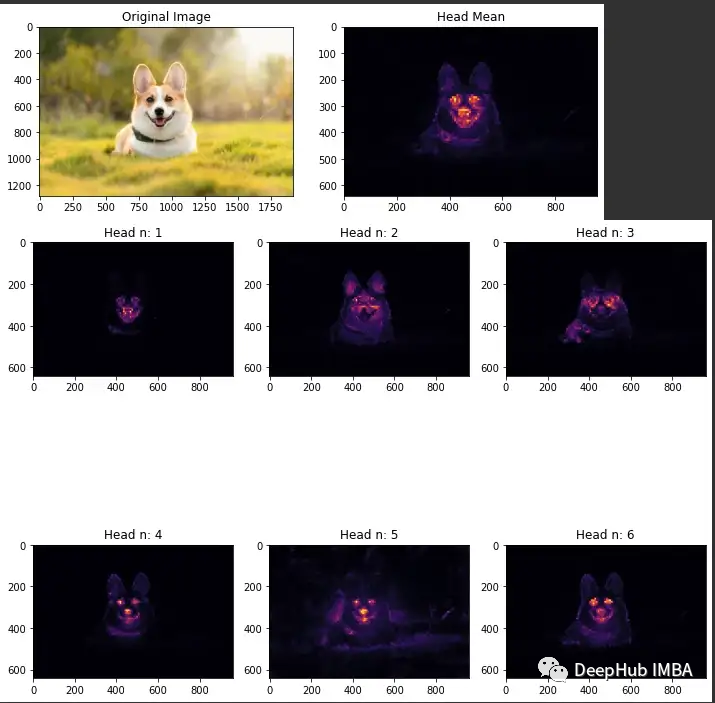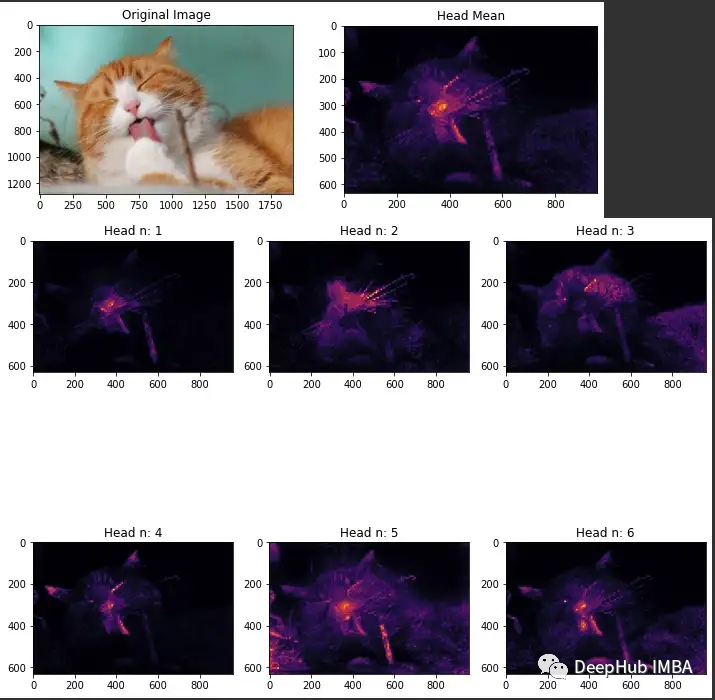可视化VIT中的注意力

来源:DeepHub IMBA
本文约4000字,建议阅读8分钟
本文为你介绍ViT模型。
2022年, Vision Transformer (ViT)成为卷积神经网络(cnn)的有力竞争对手,卷积神经网络目前是计算机视觉领域的最先进技术,广泛应用于许多图像识别应用。在计算效率和精度方面,ViT模型超过了目前最先进的(CNN)几乎四倍。
ViT是如何工作的?
ViT模型的性能取决于优化器、网络深度和特定于数据集的超参数等, 标准 ViT stem 采用 16 *16 卷积和 16 步长。

CNN 将原始像素转换为特征图。然后,tokenizer 将特征图转换为一系列令牌,这些令牌随后被送入transformer。然后transformer使用注意力方法生成一系列输出令牌。
projector 最终将输出令牌标记重新连接到特征图。
vision transformer模型的整体架构如下:
- 将图像拆分为补丁(固定大小)
- 展平图像块
- 从这些展平的图像块中创建低维线性嵌入
- 包括位置嵌入
- 将序列作为输入发送到transformer编码器
- 使用图像标签预训练 ViT 模型,然后在广泛的数据集上进行训练
- 在图像分类的下游数据集进行微调
可视化注意力
ViT中最主要的就是注意力机制,所以可视化注意力就成为了解ViT的重要步骤,所以我们这里介绍如何可视化ViT中的注意力。
导入库
import os import torch import numpy as np import math from functools import partial import torch import torch.nn as nn
import ipywidgets as widgets import io from PIL import Image from torchvision import transforms import matplotlib.pyplot as plt import numpy as np from torch import nn
import warnings warnings.filterwarnings("ignore")创建一个VIT
def trunc_normal_(tensor, mean=0., std=1., a=-2., b=2.): # type: (Tensor, float, float, float, float) -> Tensor return _no_grad_trunc_normal_(tensor, mean, std, a, b)
def _no_grad_trunc_normal_(tensor, mean, std, a, b): # Cut & paste from PyTorch official master until it's in a few official releases - RW # Method based on https://people.sc.fsu.edu/~jburkardt/presentations/truncated_normal.pdf def norm_cdf(x): # Computes standard normal cumulative distribution function return (1. + math.erf(x / math.sqrt(2.))) / 2.
def drop_path(x, drop_prob: float = 0., training: bool = False): if drop_prob == 0. or not training: return x keep_prob = 1 - drop_prob # work with diff dim tensors, not just 2D ConvNets shape = (x.shape[0],) + (1,) * (x.ndim - 1) random_tensor = keep_prob + \ torch.rand(shape, dtype=x.dtype, device=x.device) random_tensor.floor_() # binarize output = x.div(keep_prob) * random_tensor return output
class DropPath(nn.Module): """Drop paths (Stochastic Depth) per sample (when applied in main path of residual blocks). """
def __init__(self, drop_prob=None): super(DropPath, self).__init__() self.drop_prob = drop_prob
def forward(self, x): return drop_path(x, self.drop_prob, self.training)
class Mlp(nn.Module): def __init__(self, in_features, hidden_features=None, out_features=None, act_layer=nn.GELU, drop=0.): super().__init__() out_features = out_features or in_features hidden_features = hidden_features or in_features self.fc1 = nn.Linear(in_features, hidden_features) self.act = act_layer() self.fc2 = nn.Linear(hidden_features, out_features) self.drop = nn.Dropout(drop)
def forward(self, x): x = self.fc1(x) x = self.act(x) x = self.drop(x) x = self.fc2(x) x = self.drop(x) return x
class Attention(nn.Module): def __init__(self, dim, num_heads=8, qkv_bias=False, qk_scale=None, attn_drop=0., proj_drop=0.): super().__init__() self.num_heads = num_heads head_dim = dim // num_heads self.scale = qk_scale or head_dim ** -0.5
self.qkv = nn.Linear(dim, dim * 3, bias=qkv_bias) self.attn_drop = nn.Dropout(attn_drop) self.proj = nn.Linear(dim, dim) self.proj_drop = nn.Dropout(proj_drop)
def forward(self, x): B, N, C = x.shape qkv = self.qkv(x).reshape(B, N, 3, self.num_heads, C // self.num_heads).permute(2, 0, 3, 1, 4) q, k, v = qkv[0], qkv[1], qkv[2]
attn = (q @ k.transpose(-2, -1)) * self.scale attn = attn.softmax(dim=-1) attn = self.attn_drop(attn)
x = (attn @ v).transpose(1, 2).reshape(B, N, C) x = self.proj(x) x = self.proj_drop(x) return x, attn
class Block(nn.Module): def __init__(self, dim, num_heads, mlp_ratio=4., qkv_bias=False, qk_scale=None, drop=0., attn_drop=0., drop_path=0., act_layer=nn.GELU, norm_layer=nn.LayerNorm): super().__init__() self.norm1 = norm_layer(dim) self.attn = Attention( dim, num_heads=num_heads, qkv_bias=qkv_bias, qk_scale=qk_scale, attn_drop=attn_drop, proj_drop=drop) self.drop_path = DropPath( drop_path) if drop_path > 0. else nn.Identity() self.norm2 = norm_layer(dim) mlp_hidden_dim = int(dim * mlp_ratio) self.mlp = Mlp(in_features=dim, hidden_features=mlp_hidden_dim, act_layer=act_layer, drop=drop)
def forward(self, x, return_attention=False): y, attn = self.attn(self.norm1(x)) if return_attention: return attn x = x + self.drop_path(y) x = x + self.drop_path(self.mlp(self.norm2(x))) return x
class PatchEmbed(nn.Module): """ Image to Patch Embedding """
def __init__(self, img_size=224, patch_size=16, in_chans=3, embed_dim=768): super().__init__() num_patches = (img_size // patch_size) * (img_size // patch_size) self.img_size = img_size self.patch_size = patch_size self.num_patches = num_patches
self.proj = nn.Conv2d(in_chans, embed_dim, kernel_size=patch_size, stride=patch_size)
def forward(self, x): B, C, H, W = x.shape x = self.proj(x).flatten(2).transpose(1, 2) return x
class VisionTransformer(nn.Module): """ Vision Transformer """
def __init__(self, img_size=[224], patch_size=16, in_chans=3, num_classes=0, embed_dim=768, depth=12, num_heads=12, mlp_ratio=4., qkv_bias=False, qk_scale=None, drop_rate=0., attn_drop_rate=0., drop_path_rate=0., norm_layer=nn.LayerNorm, **kwargs): super().__init__() self.num_features = self.embed_dim = embed_dim
self.patch_embed = PatchEmbed( img_size=img_size[0], patch_size=patch_size, in_chans=in_chans, embed_dim=embed_dim) num_patches = self.patch_embed.num_patches
self.cls_token = nn.Parameter(torch.zeros(1, 1, embed_dim)) self.pos_embed = nn.Parameter( torch.zeros(1, num_patches + 1, embed_dim)) self.pos_drop = nn.Dropout(p=drop_rate)
# stochastic depth decay rule dpr = [x.item() for x in torch.linspace(0, drop_path_rate, depth)] self.blocks = nn.ModuleList([ Block( dim=embed_dim, num_heads=num_heads, mlp_ratio=mlp_ratio, qkv_bias=qkv_bias, qk_scale=qk_scale, drop=drop_rate, attn_drop=attn_drop_rate, drop_path=dpr[i], norm_layer=norm_layer) for i in range(depth)]) self.norm = norm_layer(embed_dim)
# Classifier head self.head = nn.Linear( embed_dim, num_classes) if num_classes > 0 else nn.Identity()
trunc_normal_(self.pos_embed, std=.02) trunc_normal_(self.cls_token, std=.02) self.apply(self._init_weights)
def _init_weights(self, m): if isinstance(m, nn.Linear): trunc_normal_(m.weight, std=.02) if isinstance(m, nn.Linear) and m.bias is not None: nn.init.constant_(m.bias, 0) elif isinstance(m, nn.LayerNorm): nn.init.constant_(m.bias, 0) nn.init.constant_(m.weight, 1.0)
def interpolate_pos_encoding(self, x, w, h): npatch = x.shape[1] - 1 N = self.pos_embed.shape[1] - 1 if npatch == N and w == h: return self.pos_embed class_pos_embed = self.pos_embed[:, 0] patch_pos_embed = self.pos_embed[:, 1:] dim = x.shape[-1] w0 = w // self.patch_embed.patch_size h0 = h // self.patch_embed.patch_size # we add a small number to avoid floating point error in the interpolation # see discussion at https://github.com/facebookresearch/dino/issues/8 w0, h0 = w0 + 0.1, h0 + 0.1 patch_pos_embed = nn.functional.interpolate( patch_pos_embed.reshape(1, int(math.sqrt(N)), int( math.sqrt(N)), dim).permute(0, 3, 1, 2), scale_factor=(w0 / math.sqrt(N), h0 / math.sqrt(N)), mode='bicubic', ) assert int( w0) == patch_pos_embed.shape[-2] and int(h0) == patch_pos_embed.shape[-1] patch_pos_embed = patch_pos_embed.permute(0, 2, 3, 1).view(1, -1, dim) return torch.cat((class_pos_embed.unsqueeze(0), patch_pos_embed), dim=1)
def prepare_tokens(self, x): B, nc, w, h = x.shape x = self.patch_embed(x) # patch linear embedding
# add the [CLS] token to the embed patch tokens cls_tokens = self.cls_token.expand(B, -1, -1) x = torch.cat((cls_tokens, x), dim=1)
# add positional encoding to each token x = x + self.interpolate_pos_encoding(x, w, h)
return self.pos_drop(x)
def forward(self, x): x = self.prepare_tokens(x) for blk in self.blocks: x = blk(x) x = self.norm(x) return x[:, 0]
def get_last_selfattention(self, x): x = self.prepare_tokens(x) for i, blk in enumerate(self.blocks): if i < len(self.blocks) - 1: x = blk(x) else: # return attention of the last block return blk(x, return_attention=True)
def get_intermediate_layers(self, x, n=1): x = self.prepare_tokens(x) # we return the output tokens from the `n` last blocks output = [] for i, blk in enumerate(self.blocks): x = blk(x) if len(self.blocks) - i <= n: output.append(self.norm(x)) return output
class VitGenerator(object): def __init__(self, name_model, patch_size, device, evaluate=True, random=False, verbose=False): self.name_model = name_model self.patch_size = patch_size self.evaluate = evaluate self.device = device self.verbose = verbose self.model = self._getModel() self._initializeModel() if not random: self._loadPretrainedWeights()
def _getModel(self): if self.verbose: print( f"[INFO] Initializing {self.name_model} with patch size of {self.patch_size}") if self.name_model == 'vit_tiny': model = VisionTransformer(patch_size=self.patch_size, embed_dim=192, depth=12, num_heads=3, mlp_ratio=4, qkv_bias=True, norm_layer=partial(nn.LayerNorm, eps=1e-6))
elif self.name_model == 'vit_small': model = VisionTransformer(patch_size=self.patch_size, embed_dim=384, depth=12, num_heads=6, mlp_ratio=4, qkv_bias=True, norm_layer=partial(nn.LayerNorm, eps=1e-6))
elif self.name_model == 'vit_base': model = VisionTransformer(patch_size=self.patch_size, embed_dim=768, depth=12, num_heads=12, mlp_ratio=4, qkv_bias=True, norm_layer=partial(nn.LayerNorm, eps=1e-6)) else: raise f"No model found with {self.name_model}"
return model
def _initializeModel(self): if self.evaluate: for p in self.model.parameters(): p.requires_grad = False
self.model.eval()
self.model.to(self.device)
def _loadPretrainedWeights(self): if self.verbose: print("[INFO] Loading weights") url = None if self.name_model == 'vit_small' and self.patch_size == 16: url = "dino_deitsmall16_pretrain/dino_deitsmall16_pretrain.pth"
elif self.name_model == 'vit_small' and self.patch_size == 8: url = "dino_deitsmall8_300ep_pretrain/dino_deitsmall8_300ep_pretrain.pth"
elif self.name_model == 'vit_base' and self.patch_size == 16: url = "dino_vitbase16_pretrain/dino_vitbase16_pretrain.pth"
elif self.name_model == 'vit_base' and self.patch_size == 8: url = "dino_vitbase8_pretrain/dino_vitbase8_pretrain.pth"
if url is None: print( f"Since no pretrained weights have been found with name {self.name_model} and patch size {self.patch_size}, random weights will be used")
else: state_dict = torch.hub.load_state_dict_from_url( url="https://dl.fbaipublicfiles.com/dino/" + url) self.model.load_state_dict(state_dict, strict=True)
def get_last_selfattention(self, img): return self.model.get_last_selfattention(img.to(self.device))
def __call__(self, x): return self.model(x)创建可视化函数
def transform(img, img_size): img = transforms.Resize(img_size)(img) img = transforms.ToTensor()(img) return img
def visualize_predict(model, img, img_size, patch_size, device): img_pre = transform(img, img_size) attention = visualize_attention(model, img_pre, patch_size, device) plot_attention(img, attention)
def visualize_attention(model, img, patch_size, device): # make the image divisible by the patch size w, h = img.shape[1] - img.shape[1] % patch_size, img.shape[2] - \ img.shape[2] % patch_size img = img[:, :w, :h].unsqueeze(0)
w_featmap = img.shape[-2] // patch_size h_featmap = img.shape[-1] // patch_size
attentions = model.get_last_selfattention(img.to(device))
nh = attentions.shape[1] # number of head
# keep only the output patch attention attentions = attentions[0, :, 0, 1:].reshape(nh, -1)
attentions = attentions.reshape(nh, w_featmap, h_featmap) attentions = nn.functional.interpolate(attentions.unsqueeze( 0), scale_factor=patch_size, mode="nearest")[0].cpu().numpy()
return attentions
def plot_attention(img, attention): n_heads = attention.shape[0]
plt.figure(figsize=(10, 10)) text = ["Original Image", "Head Mean"] for i, fig in enumerate([img, np.mean(attention, 0)]): plt.subplot(1, 2, i+1) plt.imshow(fig, cmap='inferno') plt.title(text[i]) plt.show()
plt.figure(figsize=(10, 10)) for i in range(n_heads): plt.subplot(n_heads//3, 3, i+1) plt.imshow(attention[i], cmap='inferno') plt.title(f"Head n: {i+1}") plt.tight_layout() plt.show()
class Loader(object): def __init__(self): self.uploader = widgets.FileUpload(accept='image/*', multiple=False) self._start()
def _start(self): display(self.uploader)
def getLastImage(self): try: for uploaded_filename in self.uploader.value: uploaded_filename = uploaded_filename img = Image.open(io.BytesIO( bytes(self.uploader.value[uploaded_filename]['content'])))
return img except: return None
def saveImage(self, path): with open(path, 'wb') as output_file: for uploaded_filename in self.uploader.value: content = self.uploader.value[uploaded_filename]['content'] output_file.write(content)对一个图像的注意力进行可视化
device = torch.device("cuda") if torch.cuda.is_available() else torch.device("cpu") if device.type == "cuda": torch.cuda.set_device(1)
name_model = 'vit_small' patch_size = 8
model = VitGenerator(name_model, patch_size, device, evaluate=True, random=False, verbose=True)
# Visualizing Dog Image path = '/content/corgi_image.jpg' img = Image.open(path) factor_reduce = 2 img_size = tuple(np.array(img.size[::-1]) // factor_reduce) visualize_predict(model, img, img_size, patch_size, device)

本文代码
https://colab.research.google.com/drive/1tRRuT21W3VUvORCFRazrVaFLSWYbYoqL?usp=sharing
编辑:于腾凯
校对:林亦霖

本文参与 腾讯云自媒体分享计划,分享自微信公众号。
原始发表:2023-01-29,如有侵权请联系 cloudcommunity@tencent.com 删除
评论
登录后参与评论
推荐阅读
目录
